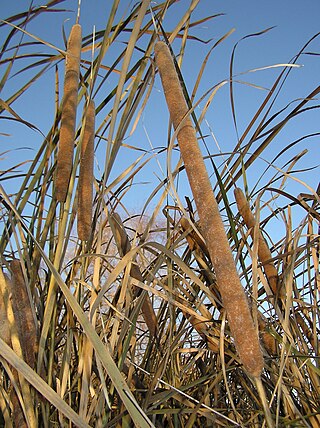Related Research Articles

Arrhenatherum, commonly called oatgrass or button-grass, is a genus of Eurasian and North African plants in the grass family.

Lolium is a genus of tufted grasses in the bluegrass subfamily (Pooideae). It is often called ryegrass, but this term is sometimes used to refer to grasses in other genera.

Festuca (fescue) is a genus of flowering plants belonging to the grass family Poaceae. They are evergreen or herbaceous perennial tufted grasses with a height range of 10–200 cm (4–79 in) and a cosmopolitan distribution, occurring on every continent except Antarctica. The genus is closely related to ryegrass (Lolium), and recent evidence from phylogenetic studies using DNA sequencing of plant mitochondrial DNA shows that the genus lacks monophyly. As a result, plant taxonomists have moved several species, including the forage grasses tall fescue and meadow fescue, from the genus Festuca into the genus Lolium, or alternatively into the segregate genus Schedonorus.
Psychrogeton is a genus of plants in the tribe Astereae within the family Asteraceae.

Tussock grasses or bunch grasses are a group of grass species in the family Poaceae. They usually grow as singular plants in clumps, tufts, hummocks, or bunches, rather than forming a sod or lawn, in meadows, grasslands, and prairies. As perennial plants, most species live more than one season. Tussock grasses are often found as forage in pastures and ornamental grasses in gardens.
Zingeria is a genus of Asian and European plants in the grass family. Their native range covers the Black Sea and eastern Mediterranean regions from Romania to Kazakhstan.
Yury Nikolaevitch Voronov was a Russian botanist. He worked at the Botanical Garden in Leningrad.

Steromphala rarilineata is a species of sea snail, a marine gastropod mollusk in the family Trochidae, the top snails.
Lachnagrostis is a genus of African, Australian, Pacific Island, and South American plants in the grass family. They are often treated as members of genus Agrostis.

Syringa pubescens is a species of flowering plant in the lilac genus of the family Oleaceae, native to Korea and China.
Festuca frederikseniae is a species of grass native to Greenland, Newfoundland, Labrador, and to a few islands in eastern Québec. In Iceland and southern Greenland, a few populations have been found that may be hybrids between F. rubra and either F. frederikseniae or F. vivipara. The purported hybrids have been named F. x villosa-vivipara. All these species grow on cliffs and on rocky or sandy soils in alpine tundra. It was first described in 1985.
Allium kurssanovii is a species of wild onion native to Central Asia. It grows on cliff faces and other sun-lit locations at elevations of 2200–2700 m.

Typha austro-orientalis is a plant species native to the southern part of European Russia. It grows in freshwater marshes. The type specimen was collected in 2000 near the City of Volgograd.
Typha tichomirovii is a plant species native to the Astrakhan Oblast in the southern part of European Russia. The species grows in freshwater marshes and along the banks of streams and lakes. The delta of the Volga River lies within Astrakhan.
Typha × smirnovii is a plant of hybrid origin, endemic to southern Russia. Initial collections were made in 1998 in the vicinity of Volgograd. The plant apparently originated as a cross between the two very widespread species T. latifolia and T. laxmannii.Typha × smirnovii grows in freshwater marshes.
Parafossarulus spiridonovi is a species of freshwater snail with gills and an operculum, an aquatic prosobranch gastropod mollusk in the family Bithyniidae.
Hookerochloa is a genus of Australian plants in the grass family.
- Hookerochloa eriopoda(Vickery) S.W.L.Jacobs - Queensland, New South Wales, Victoria
- Hookerochloa hookeriana(F.Muell. ex Hook.f.) E.B.Alexeev - New South Wales, Victoria, Tasmania
Parafestuca is a genus of plants in the grass family. The only known species is Parafestuca albida, found only on the Portuguese Island of Madeira in the North Atlantic.

Iris glaucescens is a plant species in the genus Iris, it is also in the subgenus Iris. It is a rhizomatous perennial, found in Russia, Kazakhstan, Mongolia and China. It has blue-grey sickle-shaped leaves, slender stem, and spring flowers in blue-violet, pale violet, lilac-purple, to deep purple, to light bluish, and almost white shades. It is rarely cultivated as an ornamental plant in temperate regions. It was merged with another similar iris in the region, and became a synonym of Iris scariosa, before being divided into two separate species again. Although some sources still call it a synonym of Iris scariosa.
Festuca sinensis is a species of grass in the family Poaceae. It is endemic to China. It is perennial and mainly grows in temperate biomes. It was first described in 1988 by Evgenii Borisovich Alexeev.
References
- 1 2 Tropicos, Austrofestuca (Tzvelev) E.B. Alexeev
- ↑ Alexeev, Eugeniy Borisovich. 1976. Bjulleten Moskovskogo Obačestva Ispytatelej Prirody, Otdel Biologičeskij 81(5): 55
- ↑ Watson L, Dallwitz MJ (2008). "The grass genera of the world: descriptions, illustrations, identification, and information retrieval; including synonyms, morphology, anatomy, physiology, phytochemistry, cytology, classification, pathogens, world and local distribution, and references". The Grass Genera of the World. Archived from the original on 2011-06-06. Retrieved 2009-08-19.
- ↑ Grassbase - The World Online Grass Flora
- ↑ Atlas of Living Australia, beach fescue, Austrofestuca littoralis (Labill.) E.B.Alexeev Archived February 13, 2015, at the Wayback Machine
- 1 2 Kew World Checklist of Selected Plant Families
- ↑ Jacobs, Surrey Wilfrid Laurance. 2008. Telopea 12(2): 277
- ↑ Alexeev, Eugeniy Borisovich. 1985. Bjulleten Moskovskogo Obačestva Ispytatelej Prirody, Otdel Biologičeskij 90(5): 106–107, f. 1, 22–31